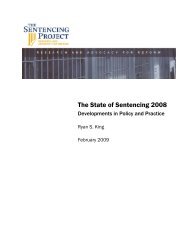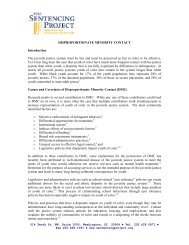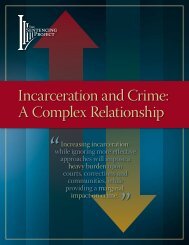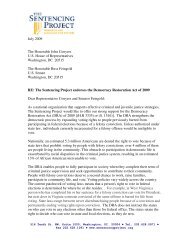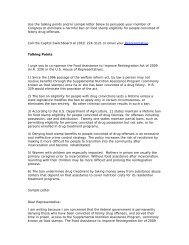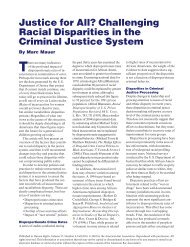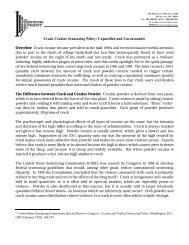VIEW PDF - The Sentencing Project
VIEW PDF - The Sentencing Project
VIEW PDF - The Sentencing Project
You also want an ePaper? Increase the reach of your titles
YUMPU automatically turns print PDFs into web optimized ePapers that Google loves.
T<br />
he juvenile justice system in the United States is in urgent need of reform<br />
and federal leadership is necessary. Despite a steady drop in juvenile<br />
detention over the past decade, there are still far too many young people<br />
securely detained for first‐time, nonviolent offenses that would not be illegal if<br />
committed by an adult (i.e., status offenses such as truancy). Nationwide each year,<br />
police make 2.1 million juvenile arrests; 1 1.7 million cases are referred to juvenile<br />
courts; 2 and over 200,000 youth are prosecuted in the adult criminal justice<br />
system. 3 On any given night, approximately 81,000 youth are confined in juvenile<br />
facilities, 4 and 10,000 children are held in adult jails and prisons. 5 Incarcerated<br />
youth are particularly vulnerable to victimization and abuse by peers, older<br />
inmates, and staff. 6 Also, the United States is alone in imposing the sentence of life<br />
without parole for crimes committed when under the age of 18. Recent estimates<br />
find that 2,589 people are currently serving a juvenile life without parole sentence<br />
for a crime committed as a juvenile. 7<br />
Current juvenile justice practices often ignore children's amenability to<br />
rehabilitation, cause long‐term collateral consequences, waste taxpayer dollars,<br />
and violate our deepest held principles about equal justice under the law and the<br />
role of the juvenile justice system. Our system demonstrates racial and ethnic<br />
disparities, lacks sound mental health and drug treatment services, and applies<br />
excessively harsh sanctions for minor and nonviolent adolescent misbehavior.<br />
With strong federal leadership, reforms are possible. Research over the past 20<br />
years has increased our understanding of what works, and how to best approach<br />
juvenile delinquency and system reform. Promising reforms are being<br />
implemented in many jurisdictions across the country, and there is an increasingly<br />
clear path for moving toward evidence‐based approaches to reducing adolescent<br />
crime. <strong>The</strong> Obama Administration has the opportunity to restore an effective<br />
system of juvenile justice for our youth and should begin by focusing on the<br />
following five priority areas:<br />
1) Restore Federal Leadership in Juvenile Justice Policy<br />
2) Support Prevention, Early Intervention, and Diversion Strategies<br />
3) Keep Court‐Involved Youth Safe<br />
4) Remove Youth from the Adult Criminal Justice System<br />
5) Support Youth Reentry<br />
1



